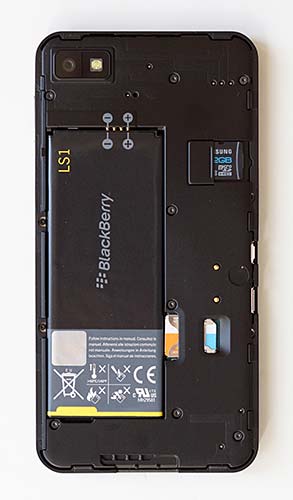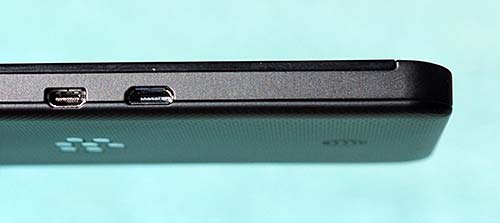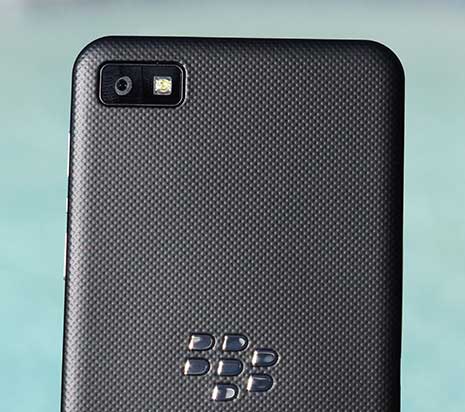BlackBerry Z10
07:21
The BlackBerry Z10, running BlackBerry 10 is finally
here in the US. AT&T is the first carrier to release the Z10, and
that's the model we'll review here, with occasional mention of the
unlocked US model STL100-3 that we also have in house. In terms of both
hardware and software, the AT&T version (also an STL-100-3) is
nearly identical to its unlocked US and Canadian cousin, and only a
small AT&T logo on the back gives it away. There are just a few
carrier apps like AT&T Family Maps and a shortcut to the AT&T
account management portal, making for a very clean experience.

This is a pure touch screen phone with
no hardware QWERTY keyboard. Instead a capable software keyboard takes
care of your text entry needs. The 4.2", 1280 x 768 IPS display is sharp
and good looking. The BlackBerry Z10 runs on a 1.5GHz dual core
Qualcomm CPU with 2 gigs of RAM and 16 gigs of internal storage. Those
are beefy enough specs to make the smartphone's pervasive multi-tasking
smooth. The Z10 has a rear 8MP camera that can shoot 1080p video and a
front 2MP camera that can shoot 720p video. Wireless is well covered
with LTE 4G and HSPA+, dual band WiFi, Bluetooth 4.0, GPS and NFC. The
phone has the mobile hotspot feature and very good reception.
Design and Ergonomics
The Z10 is a pleasing looking smartphone that's relatively compact by today's standards. At 4.2", the Z10 feels a lot like the iPhone 5s
in terms of size and screen dimensions. I personally prefer larger
displays at 4.5" and above for the larger text and more immersive video
watching experience, but there's something to be said for a phone that's
still small enough to be comfortable to use as a phone. It fits easily
enough in a pocket and the textured, rubbery back isn't slippery. The
phone is largely make of plastic with an stainless steel inner frame,
stainless steel buttons and the front could fool you because it looks so
much like metal. The look is strikingly similar to the iPhone 5 and HTC
One from the front, but Apple and HTC's offering look much classier
from the back and more exciting overall. That said, the BlackBerry Z10
is attractive looking, even if it doesn't wander far from the black slab
look (Verizon customers have the option to get a white Z10 along with
the usual black model).

We won't complain too much about that
plastic back because it allows for a thin phone with a removable rear
cover. That means you can swap out the battery and there's an SDXC
microSD card slot under the back cover as well as the micro SIM card
slot. Removable batteries and storage cards seem to be going the way of
the angels, so we're thrilled to see it here. Given BlackBerry's
government and business heritage, the ability to swap in a spare battery
on the road is a must.
Controls are easy to use, and we like
that the center button that's sandwiched between the volume buttons does
double duty to bring up voice command. However, we found voice command
selection limited and the phone's voice recognition skills mediocre--it
doesn't compete with Siri or the very good voice recognition system in
Android. Even Windows Phone does better (Windows Phone 8 has excellent
recognition skills but a limited set of commands).
The power button up top is just right:
easy to press when you want it, but not easy to press accidentally. The
smartphone has both micro USB (for charging and data transfer) and a
micro HDMI port on the left side. The front camera is offset to the
right side just a bit and the rear camera is at the upper right corner
beside an LED flash. And no, there's no home button, be it physical or
software-based. As you'd expect from a BlackBerry, there's a
notification LED on the front above the display.
BlackBerry OS 10
The smartphone's fresh new OS reminds us
strongly of the PlayBook, which in turn reminds of us of webOS. The
icons have that signature BlackBerry styling as do menu fonts, but the
swipe gestures are pure PlayBook (with a nod to webOS gestures and card
metaphor). BlackBerry OS 10 and the PlayBook OS have a lot in common,
with a foundation in the very robust and secure QNX operating system.
The good news is that the phone is fast and fluid and extremely stable.
It doesn't slow down after a day or two and require a reboot as Android
sometimes does. We had the web browser quit once in the middle of a page
load, but that didn't take down the OS and it only happened once in 10
days of use.
Flow, or gestures are the heart of
navigation, and they're optimized for one-handed use. Swipe up to
minimize an application and it will then become an "Active Pane" that
runs at 1/4 screen size. Some apps will update in Active Pane mode, and
it's hard to guess which ones, and you can have up to 8 apps running in
this multi-tasking mode. Start a ninth app and the OS will start closing
other running apps (or you can tap the little x at the top right corner
of an Active Pane to close that app yourself).
Your home screen is a three part
experience: a multi-screen palette of icons much as you see on the
iPhone and Android, the Active Pane multi-tasking area where you can
swipe up and down to view all open apps and the BlackBerry Hub that
serves as your one-stop location for text messages, emails, social
network status updates, reminders and app update notices. You'll swipe
from side to side to access these three main areas. When in an app that
has menu options, you'll either see three stacked dots on the bottom
right edge of the screen or you can swipe down to see any available
options. This isn't consistent from app to app, unfortunately.
We found the keyboard easy to use and
text prediction was quick and rational. You can accept a suggested word
with a swipe up, which isn't the quickest way to do things in terms of
usability, but BlackBerry is clearly in love with swipe gestures.
Overall, this is one of the best on-screen keyboards on the market.
The smartphone market is a ruthlessly
competitive place, and I must say that BlackBerry was smart to wait
until their new OS was super-stable, fast and feature complete. Remember
not so long ago Apple and Android came out missing basic features like
third party app support (iOS), cut and paste (iOS, Android and Windows
Phone) and multi-tasking (iOS and Windows Phone). Fast forward a few
years and it isn't even worthwhile to release an OS missing those
staples. All the basics are here with BlackBerry OS 10, and we applaud
them, even if they don't have a "killer feature" that competing
operating systems lack.
BlackBerry Hub and Email
I love BlackBerry Hub, I confess. One
place to look at and interact with all the things important: what a
godsend! From email to texts to software update notices and tweets; it's
all there. Twitter messages are threaded, which is wonderful if you
have a lot of twitter conversations with strangers as I do. You can
reply to social network messages, emails and texts directly from Hub,
and in fact there's no dedicated email application. Yes, the phone has
email with support for MS Exchange, Exchange Activesync, POP, IMAP
(including IMAP idle for a push-like experience), but there's no icon
for an email app, let alone the separate email icons BlackBerry 7
provided for each email account.
BlackBerry was synonymous with world
class email for years, and now it's one of the platform's less stellar
features. I confess, a unified email inbox just doesn't work for me as a
business user: I need to jump on my important work emails first, and
worry about my personal accounts only when I have time. I don't really
want them mixing, and I'm not thrilled at having to tap on the Hub's
caret to filter my email account view. Since I'm not a BES 10 user, I
can't rely on BlackBerry's nifty BlackBerry Balance feature to separate
personal and business emails. That's me, maybe you'll love it. I don't
like the unfied iOS inbox either. Folder management has been a bit buggy
for me (sometimes emails in folders don't appear) and mass message
management shouldn't involve hunting (tap and hold on a message until a
side menu appears, then you can choose the "Select More" function- it's
the last option).
Gmail is handled as IMAP idle
automatically since Google stopped offering Exchange Activesync for free
accounts on Feb. 1, 2013. If you pay Google $5/month, you can have your
EAS back. The first time I set up my Gmail account, it took about 10
minutes for new messages to come to the Z10, while they arrived
instantly on my Samsung Galaxy Note II, Nokia Lumia 920 and iPhone 5s
running the Gmail app. IMAP idle should be quicker than that... so I
deleted my Gmail accounts and created them again. Second time it worked
fine and emails arrived within 15 seconds of my other phones. Quirky. On
a positive note, HTML emails look lovely and Exchange works like a
charm. You can use the phone with BES 10 (BlackBerry Enterprise Server)
but not BIS.
Software Selection: Just Starting Out
As ever with a new smartphone OS, app
selection is slim. Surprisingly, game selection is a strong point in the
fledgling BlackBerry World that now also offers video purchase and
rentals in partnership with Rovi and a music store. Apps like Netflix
are MIA but WhatsApp, Flixster and Adobe Reader are there. The phone
ships with a good starter set of apps including Docs to Go for your MS
Office needs (view, edit and create MS Word and Excel and view/edit
PowerPoint), a pretty calculator designed by The Astonishing Tribe, PIM
apps, BBM, Adobe Reader, Twitter, Facebook, LinkedIn, Foursquare, Box
and DropBox as well as a file manager. There's a YouTube app (actually a
shortcut to the mobile YouTube site), weather, a clock with alarms,
mediocre voice command and a very good HTML5 web browser with Adobe
Flash support and a Reader mode that works more reliably than the
iPhone's. BlackBerry Maps offers basic 2D maps with no POIs and 3D
driving directions with spoken navigation. BlackBerry Hub brings text
messaging, reminders, email and BBM together along with social
networking updates. BlackBerry says there are currently 100,000 apps in
BlackBerry World, but this is quantity over quality. Many name brand
popular apps from iOS and Android aren't here, but there are a lot of
junk apps. Too many. We'd love to see BlackBerry raise the bar for apps
because these low quality apps don't make a good impression.
As a consolation, it's supposed to be
fairly easy for developers to port their Android apps over to BlackBerry
10, so we should see app selection continue to grow quickly. These
non-native apps tend to run a bit slower, but for lightweight apps, it's
hardly a problem. Creative geeks can grab Android apk app files and
self-sign them and send them to their BlackBerry Z10 over USB. If you
understand what I just said, this might be for you. If not, it's
probably too techy or tedious.
Call Quality and Data
The BlackBerry Z10 is an excellent voice
phone with near landline clarity and fullness for incoming and outgoing
voice. Volume is average for incoming voice and louder than average for
outgoing voice. The speakerphone is very effective (we like it better
for speakerphone than multimedia), and it's loud enough for big box
stores.
Data speeds on AT&T's LTE network
with both the AT&T version and the unlocked model are very good.
There's still no good speed test app in BlackBerry World, but
subjectively websites loaded quickly and app downloads were speedy.
Reception is very good and the phone doesn't suffer death grip reception
drops when you wrap your hand around it.
Display and Multimedia
The BlackBerry Z10 has a superb 4.2"
1280 x 768 IPS touch screen with 356ppi pixel density and it's one of
the better looking on the market. It's right up there with the iPhone 5
and HTC One X for viewing angles, sharpness and colors. It's also bright
enough to be easily viewable in sunlight. Top and bottom bands protect
the glass since this isn't Gorilla Glass. Text is very sharp and videos
look great, though color saturation isn't quite as high as the iPhone 5
or Nokia Lumia 920. The BlackBerry Z10 supports a fairly wide variety of
video formats including MOV, MPEG4, WMV, Xvid and AVI. Throw your
movies on a microSD card and the built-in video player will find them
and play them. The bottom-firing speaker isn't all that loud but it is
clear and doesn't distort. Audio through headphones and stereo Bluetooth
is quite good.
Battery Life
I miss a few things from BlackBerry 7,
including scheduled on-off times and better control over display
brightness. The ambient light sensor never sleeps: there's no way to
disable it. That means if you set the phone to max brightness (and
you'll probably end up doing just that), you won't get max brightness.
Instead you'll get a relatively brighter setting that's still dimmed if
the phone is indoors under so-so lighting. Scheduled on-off is gone, but
there is an easy to access quiet mode for bedtime that you'll see on
the lock screen (swipe down to activate it from the lock screen). This
brings up the beloved BlackBerry bedside clock with quick access to
alarms, which will work in bedside mode.
The BlackBerry Z10 has a removable 1800
mAh Lithium Ion battery. That's not a huge capacity battery by today's
smartphone standards, but it's sufficient to power the phone through a
day of moderate use. When the phone first launched in Canada and a few
other markets a month ago, battery complaints were common, but
BlackBerry has released an OS update with 60 battery tweaks and the
AT&T Z10 is running that updated OS. Battery life has been perfectly
reasonable for a modern smartphone, though the BlackBerry Z10 doesn't
trounce the competition--it merely keeps up. The phone charges fairly
quickly: it took 2.4 hours to charge the battery from 10% to 100% and
just an hour to charge it from 40% to 100%. If you're a moderate user,
you'll charge the Z10 daily, and if you're a light user you'll charge it
every other day. If you're a heavy user, you'll need to top up by late
afternoon or buy a spare battery.




0 comments